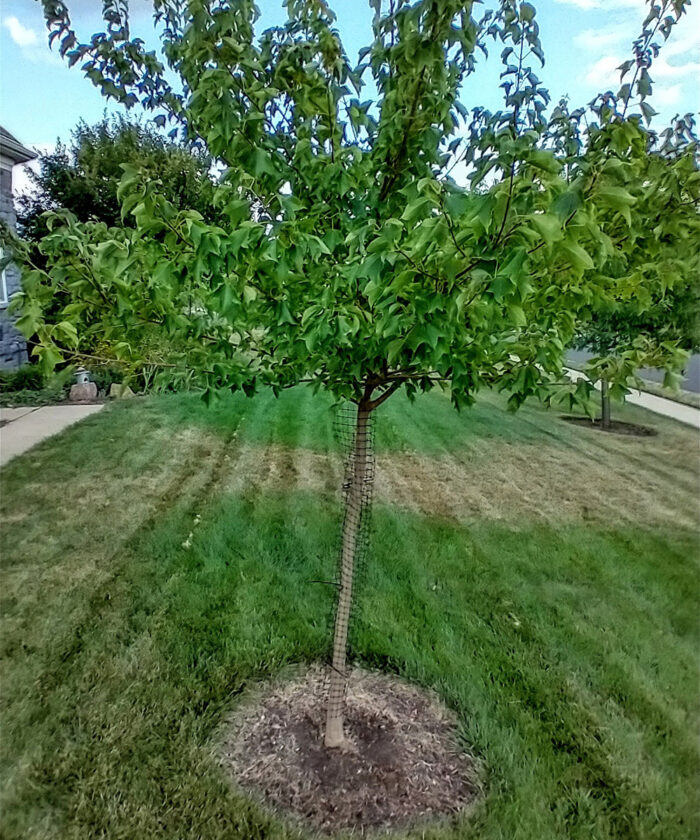
When you’ve gone to the trouble of finding exactly the right tree for your garden, it makes sense that you’d want to give it every possible advantage at planting time. The first few years after planting are a critical time for a young tree to grow, establish sufficient roots, and become resilient. Fortunately, there are plenty of things a gardener can do to help during this pivotal period.

Prepping to plant
As soon as a new tree is delivered, remove all packaging from the trunk and branches, including plastic, rope, wrap, and the nursery stake. For trees that have been balled and burlapped (B&B)—which means the soil and root ball have been dug up from a nursery field and wrapped with burlap and a wire cage—remove as much of the burlap, wire cage, and twine as possible. If you can’t get it all, cut off the top one-third to one-half of the wire cage and burlap. If the tree is in a plastic container, remove the entire root mass from the container.
Next, carefully dig a planting hole that is as deep as the root ball is tall and two to three times wider, tapering the sides. Avoid sites with compacted soil, since the tree’s roots may not be able to grow past their original planting hole to find water, air, and nutrients.

If the tree was in a plastic container, find and expose the root collar, and loosen and pull away roots from the sides and bottom of the root mass, especially those that are girdling the trunk or circling the pot. Place the root mass into the planting hole with the root collar slightly above soil grade.
Getting your tree in the ground
To prepare the root mass of a B&B tree for planting, find and expose the root collar. Place the root ball into the planting hole with the root collar slightly above soil grade.
Backfill the planting hole with the same original soil. Check that the tree trunk is vertical and straight. Staking is optional; it is most useful if the root ball is unstable or if the trunk is bending.

Post-planting procedure
Water the tree with at least 5 gallons at planting time. During the first three years, check the soil moisture 6 inches below the surface at least weekly and more often during hot, dry weather. Water when dry, providing about 2 gallons of water per inch of trunk diameter. A rule of thumb is that a new tree needs about 10 gallons of water weekly as a deep soaking.
Apply organic mulch around the tree base. Done correctly, mulching retains soil moisture, provides nutrients, and discourages weeds. Place a 2- to 4-inch layer of organic mulch (e.g., shredded bark, hardwood chips, shredded leaves, or screened compost) on top of the soil, extending out at least 3 feet from the trunk. Pull the mulch back 3 to 5 inches away from the trunk’s base. Excessive mulch piled against a tree’s trunk causes root problems.
Prune branches sparingly, removing any that are dead, damaged, diseased, or dying, since these can provide a point of entry for insects and diseases.
- For ideas on how to buy a tree, check out Tree-Shopping Tips
- For more information on proper pruning tools and techniques, check out our Pruning Project Guide.
- To learn more about the trees that grow best in your region and how to care for them, contact your local Cooperative Extension Service, and check the USDA Forest Service’s Tree Owner’s Manual.
—Thomas J. Mrazik is a horticulturist, a garden writer, and the owner of Goodly Gardens in Worcester, Pennsylvania.
Fine Gardening Recommended Products

DeWalt Variable-Speed Cordless Reciprocating Saw with 6-Piece Saw Blade Set
Fine Gardening receives a commission for items purchased through links on this site, including Amazon Associates and other affiliate advertising programs.
- 18.31 x 6.13 x 4 inches
- 1-1/8-inch stroke length
- Variable speed trigger with 0-3000 spm
- DW4856 Metal/Woodcutting Reciprocating Saw Blade Set, 6-Piece

The Nature of Oaks: The Rich Ecology of Our Most Essential Native Trees
Fine Gardening receives a commission for items purchased through links on this site, including Amazon Associates and other affiliate advertising programs.

DeWalt Variable-Speed Cordless Reciprocating Saw
Fine Gardening receives a commission for items purchased through links on this site, including Amazon Associates and other affiliate advertising programs.
- 18.31 x 6.13 x 4 inches
- 1-1/8-inch stroke length
- Variable speed trigger with 0-3000 spm


















Comments
Log in or create an account to post a comment.
Sign up Log in